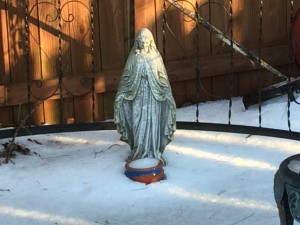
Many of people I would call “Neo-Contemplatives” that I have met within Catholicism have a contemplative prayer practice that revolves almost exclusively around “word-based practices” like Centering Prayer or Lectio Divina. While I practice Lectio, I consider myself a poor “word-based” practitioner and so the majority of my practice is centered on Marian devotion with a healthy thrust toward my patron saint.
I’m aware that I leave myself open to charges of superstition, magical thinking, or worse from my contemplative Protestant brothers and sisters. It may even receive a healthy “eyebrow raise” from many Catholic contemplatives as well. Allow me to briefly clarify.
First, the Church’s theology assumes a deeply incarnational and embodied approach to the faith and so the sacramental and the contemplative feed each other. For this reason, the Church encourages devotion to the Saints and to Mary. This type of devotion also makes sense if we take seriously the continued presence of those who have died in the faith. So my contemplative practice is not anything new nor superstitious. Instead, it is taking seriously the fullest dimensions of contemplation.
For me, every moment of contemplative encounter that I have engaged in has been a result of surrender on my behalf. I am convinced that contemplation is essential to deepen my faith and my prayer life. Yet I am also convinced, that I am the worst contemplative Christian to walk the planet earth. I need help. And while I feel like I am horrible at making time for silent prayer, I am even worse in asking for help! This is where devotion to the Saints comes in. Learning to surrender to my need for assistance is helped by ritual embodied action. Whether that embodied action is the lighting of incense, the lighting of a candle to a saint, or just asking for intercession, these activities moves me away from words and thoughts and opens my mind, heart, and will. It also allows me to drop the belief that I somehow am doing anything. I actually have to trust in the divine assistance and encounter of the moment. If I look for the pathway to encounter in ways that assume that I myself can find it, then I feel like I’ve left the path of the Tradition. And why would I want to leave a nicely worn path for one one that I have to create anew?
Contemplation is a walk into the darkness and Mystery of the Faith. Having Mary and the Saints as guides allows me to walk in confidence in their abilities and not mine. I’ve been working on a practical theology of surrender for years. Maybe it is time to take it back up. Ultimately, in the Christian tradition, we cannot do anything on our own. Even the desire to pray itself originates in a response to the Holy Spirit. I feel, therefore, that devotion is a step toward this response with a recognition that my response is one of many. I surrender myself to the love of all those that have come before. Personally, I connected with the Blessed Mother almost immediately and most of my encounters with the divine have occurred thorough asking for her help. My experience here aligns with the tradition as Mary has always been seen as a great contemplative and it is quite common for monks and contemplatives to turn to Mary as a model and a helper in prayer. I think it’s time for those of us in the Church that feel called to a deepened prayer life through contemplative prayer practices to recapture this ancient practice of looking to the saints and Marian devotion and recast it in a light of our own. These things aren’t bad thinking or old-fashioned or superstitious. Instead, I have found devotion is deeply contemplative and helpful.












